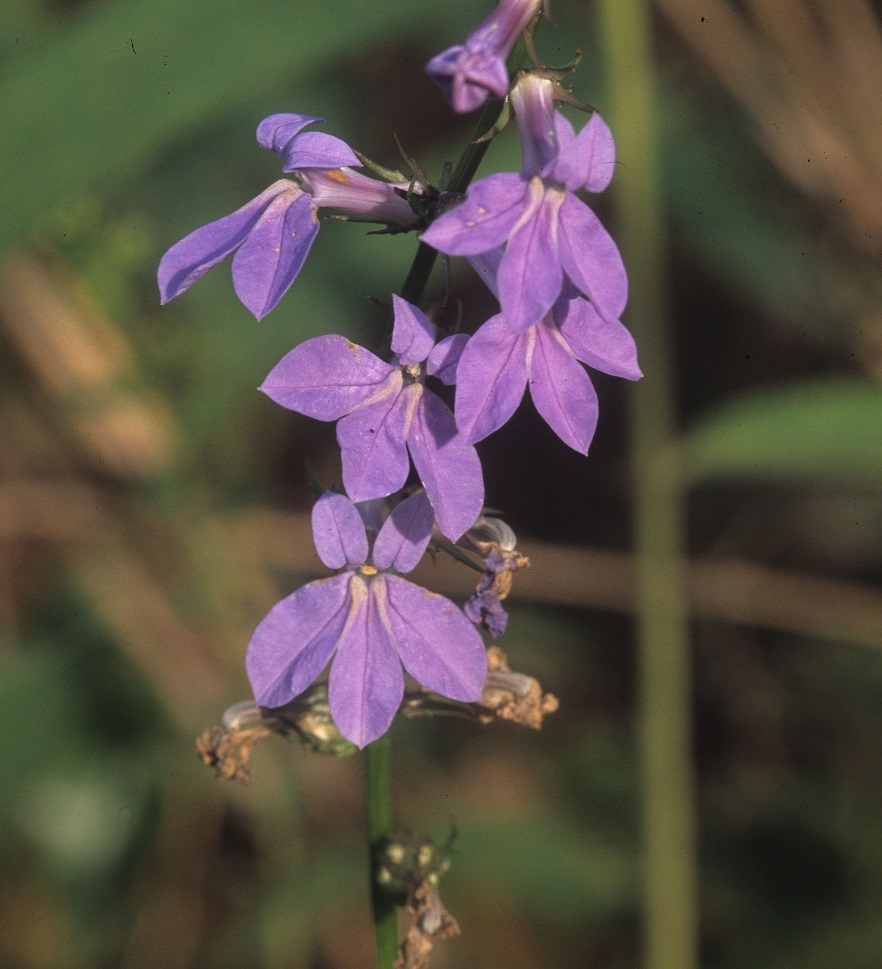Lobelia amoena
| Lobelia amoena | |
|---|---|

| |
| Photo taken by Gil Nelson | |
| Scientific classification | |
| Kingdom: | Plantae |
| Division: | Magnoliophyta - Flowering plants |
| Class: | Magnoliopsida – Dicotyledons |
| Order: | Campanulales |
| Family: | Campanulaceae |
| Genus: | Lobelia |
| Species: | L. amoena |
| Binomial name | |
| Lobelia amoena Michx. | |

| |
| Natural range of Lobelia amoena from USDA NRCS Plants Database. | |
Common name: Southern lobelia[1]
Contents
Taxonomic notes
Synonyms: none.[1]
Varieties: none.[1]
Description
"Perennial or annual herbs stems erect, strict or freely branched. Leaves crenate, serrate, or entire. Raceme terminal, bracteate, often very leafy and the flowers appearing axillary. Calyx 5-lobed, more or less actinomorphic; corolla zygomorphic, fenestrate, 2-lipped, upper lip 2-lobbed, lower 3-lobbed. Stamens 5, completely united. Capsule dehiscent by apical pores. Seeds yellowish brown, tuberculate, oblong, 0.6-1 mm long."[2]
"Similar to L. elongata. Leaves elliptic to lanceolate, 4-15 cm long, 2-4 cm wide. Sepals entire or remotely glandular-serrate; corolla tube 7-9 mm long; filament tube 5-7 mm long. Capsule 6-8 mm broad."[2]
Distribution
This species ranges from western North Carolina and eastern Tennessee to western South Carolina, central Georgia, and east-central Alabama. There are disjunct populations in the Florida Panhandle and the Coastal Plain of Georgia and South Carolina.[1]
Ecology
Habitat
This species grows in floodplain forests, semi-open wetlands, along river and stream banks, seepage bogs, and low depressions.[3] It grows in shaded to deeply-shaded environments in wet or dry sands and loam of mesic wooded environments.[3] L. amoena also grows in human-disturbed areas such as roadside ditches and clear-cut woods.[3] L. amoena responds negatively to soil disturbance by heavy silviculture in North Carolina.[4] Associated species include Boltonia, Commelina, Coreopsis integrifolia, Physostegia virginiana, Woodwardia areolata, Quercus, Rhamnus, oakleaf hydrangea, Conoclinium, Pluchea, Leersia, Panicum, Schoenus, Juniperus, Solidago fistulosa, and Bidens alba.[3]
Phenology
This species flowers from late July to October.[1]
Fire ecology
This species has been found in annually burned areas.[3]
Conservation and management
Cultivation and restoration
Photo Gallery
References and notes
- ↑ 1.0 1.1 1.2 1.3 1.4 Weakley, A.S. 2015. Flora of the southern and mid-atlantic states. Working Draft of 21 May 2015. University of North Carolina at Chapel Hill, Chapel Hill, North Carolina.
- ↑ 2.0 2.1 Radford, Albert E., Harry E. Ahles, and C. Ritchie Bell. Manual of the Vascular Flora of the Carolinas. 1964, 1968. The University of North Carolina Press. 1005-7. Print.
- ↑ 3.0 3.1 3.2 3.3 3.4 Florida State University Robert K. Godfrey Herbarium database. URL: http://herbarium.bio.fsu.edu. Last accessed: June 2014. Collectors: Loran C. Anderson, W. W. Baker, A. Gholson Jr., James P. Gillespie, Robert K. Godfrey, D. Hall, R. Komarek, R. Kral, N. Lee, Sidney McDaniel, Richard S. Mitchell, Gil Nelson, R. A. Norris, Camm Swift, D. B. Ward, and Rodie White. States and Counties: Florida: Calhoun, Franklin, Gadsden, Jackson, Leon, Liberty, Wakulla, Walton, Washington. Georgia: Grady and Thomas.
- ↑ Cohen, S., R. Braham, and F. Sanchez. (2004). Seed Bank Viability in Disturbed Longleaf Pine Sites. Restoration Ecology 12(4):503-515.